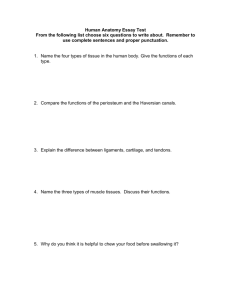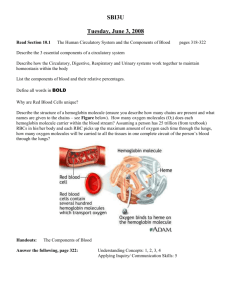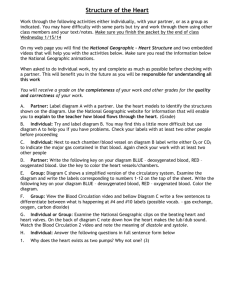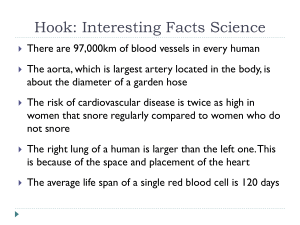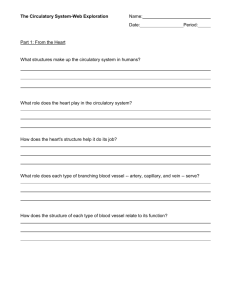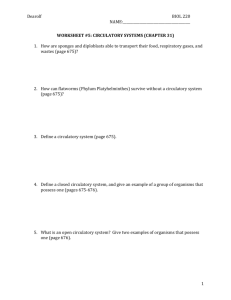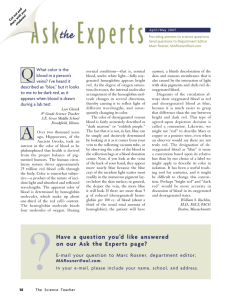The Circulatory System
advertisement
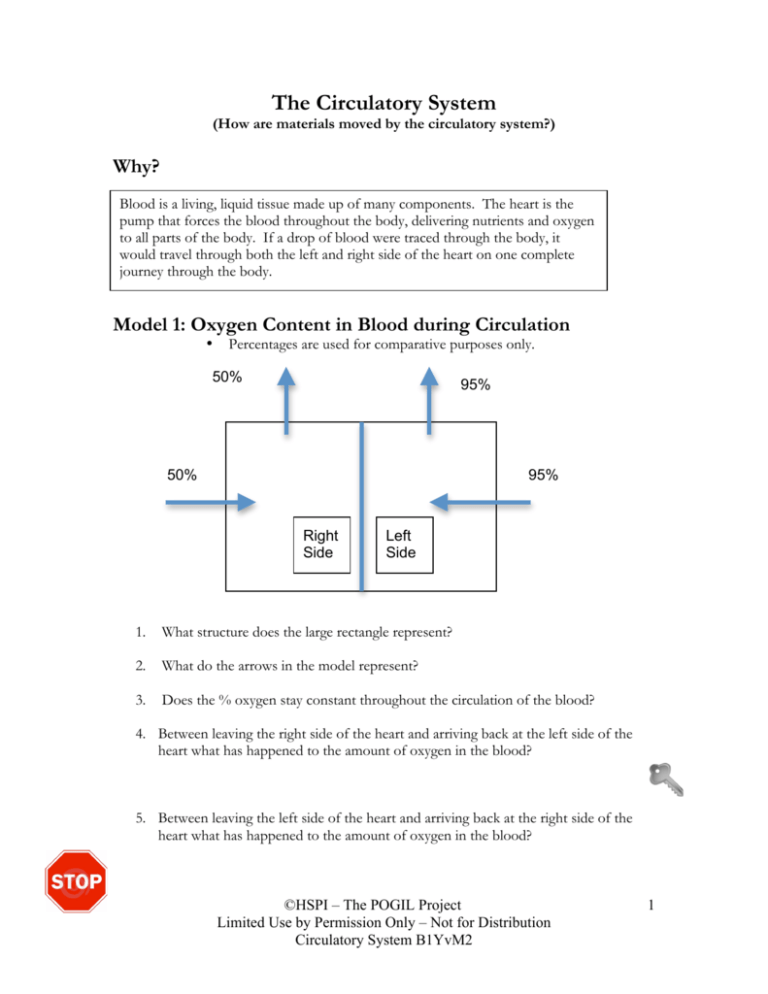
The Circulatory System (How are materials moved by the circulatory system?) Why? Blood is a living, liquid tissue made up of many components. The heart is the pump that forces the blood throughout the body, delivering nutrients and oxygen to all parts of the body. If a drop of blood were traced through the body, it would travel through both the left and right side of the heart on one complete journey through the body. Model 1: Oxygen Content in Blood during Circulation • Percentages are used for comparative purposes only. 50% 95% 50% 95% Right Side Left Side 1. What structure does the large rectangle represent? 2. What do the arrows in the model represent? 3. Does the % oxygen stay constant throughout the circulation of the blood? 4. Between leaving the right side of the heart and arriving back at the left side of the heart what has happened to the amount of oxygen in the blood? 5. Between leaving the left side of the heart and arriving back at the right side of the heart what has happened to the amount of oxygen in the blood? ©HSPI – The POGIL Project Limited Use by Permission Only – Not for Distribution Circulatory System B1YvM2 1 Model 2: Circulation of Blood A 50% 95% 50% Right Side Left Side 95% B 6. To what letter on the diagram did the blood flow to in between leaving the right side and re-entering the left side? 7. What structure in the body would this letter represent? 8. How does this explain what happened to the amount of oxygen? 9. To what letter on the diagram did the blood flow to in between leaving the left side and re-entering on the right side? 10. What structure(s) in the body would this letter represent? 11. How does this explain what happened to the amount of oxygen? ©HSPI – The POGIL Project Limited Use by Permission Only – Not for Distribution Circulatory System B1YvM2 2 Read This Blood that contains higher levels of oxygen is called oxygenated blood. Blood with lower levels of oxygen is called deoxygenated blood. The circuit that carries deoxygenated blood from the right side of the heart and brings oxygenated blood back to the left side of the heart is called the pulmonary circuit. The circuit that carries oxygenated blood from the left side of the heart and then returns deoxygenated blood from the body back to the right side of the heart is called the systemic circuit. 12. Shade the diagram, including the arrows as follows: a. Use red to represent oxygenated blood. b. Use blue to represent deoxygenated blood. 13 What is the name of the circuit that connects the heart & lungs? 14. What is the name of the circuit that connects the heart to all parts of the body except the lungs? 15. The blood on the right side only contains 50% oxygen, but it has 95% total gases. What gas other than oxygen do you think might be dissolved in the blood on the right side of the heart? 16. What process produced this gas? 17. What happens to this gas before the blood re-enters the left side of the heart? 18. Looking at the arrows on the model, how would you describe the flow pattern of the blood inside the circulatory system? 19. What features might the entrances and exits to the heart need in order to maintain this flow pattern? ©HSPI – The POGIL Project Limited Use by Permission Only – Not for Distribution Circulatory System B1YvM2 3 Extension Questions 20. A “hole in the heart” is actually a hole in the wall dividing the left and right sides of the heart. This dividing wall is called the septum. This causes the deoxygenated blood from the right side to mix with the oxygenated blood from the left side. What do you think the effects are for someone with a hole in the heart? 21. Oxygen is carried in the blood by red blood cells. At high altitudes the body cannot take in as much oxygen because of the low pressures, so to compensate your body produces more red blood cells. Even when you return to low altitudes these extra red blood cells remain for about 2 weeks. Using this information, why do you think athletes often train at high altitudes before a competition, and how does this help them? ©HSPI – The POGIL Project Limited Use by Permission Only – Not for Distribution Circulatory System B1YvM2 4 Teacher’s Guide & Answer Key Learning Objectives: After completing the activity, the students should be able to: Content: 1. Determine what happens to the amount of oxygen in the heart as the blood leaves the right side of the heart and then returns to the left side of the heart. 2. Explain why and how the oxygen amount changes from the right side of the heart to the left side of the heart. 3. Understand how the valves in the heart control the one-way flow of blood. Prerequisites: The students will have previously learned the process of cellular respiration which requires oxygen and produces carbon dioxide. They will need to apply that knowledge to answer some of the questions. Evaluation Questions: 1. To which side of the heart is deoxygenated blood returned from the body? Right 2. What is the function of valves within the circulatory system? Maintain one way flow 3. Which is the correct order of blood flow through the circulatory system? a. Left side – lungs – right side- body b. Left side – lungs – body – right side c. Right side – lungs – left side – body d. Right side – lungs – body – left side Target Audience: This activity could be used in a lower level 1st year class with some previous information and a follow-up lesson on the structure of an actual heart, using a model or a specimen. Materials: Red and blue pencils Teacher Tips: A diagram of the heart showing the septum may be useful when students are answering the extension questions. ©HSPI – The POGIL Project Limited Use by Permission Only – Not for Distribution Circulatory System B1YvM2 5 Answer Key: 1. What structure does the large rectangle in Mode l 1represent? The heart 2. What do the arrows in the model represent? The direction of the flow of blood. 3. Does the % oxygen stay constant throughout the circulation of the blood? no 4. Between leaving the right side of the heart and arriving back at the left side of the heart what has happened to the amount of oxygen in the blood? The amount of oxygen in the blood has increased. 5. Between leaving the left side of the heart and arriving back at the right side of the heart what has happened to the amount of oxygen in the blood? The amount of oxygen in the blood has decreased. 6. To what letter on the diagram did the blood flow to in between leaving the right side and re-entering the left side? A 7. What structure in the body would this letter represent? lungs 8. How does this explain what happened to the amount of oxygen? Picked up by breathing 9. To what letter on the diagram did the blood flow to in between leaving the left side and re-entering on the right side? B 10. What structure(s) in the body would this letter represent? All body organs/tissues 11. How does this explain what happened to the amount of oxygen? Dropped off oxygen 12. Shade the diagram, including the arrows as follows: a. Use red to represent oxygenated blood. b. Use blue to represent deoxygenated blood. 13. What is the name of the circuit that connects the heart & lungs? Pulmonary 14. What is the name of the circuit that connects the heart to all parts of the body except the lungs? Systemic 15. The blood on the right side only contains 50% oxygen, but it has 95% total gases. What gas other than oxygen do you think might be dissolved in the blood on the right side of the heart? Carbon dioxide 16. What process produced this gas? Cellular respiration ©HSPI – The POGIL Project Limited Use by Permission Only – Not for Distribution Circulatory System B1YvM2 6 17. What happens to this gas before the blood re-enters the left side of the heart? Breathed out 18. Looking at the arrows on the model, how would you describe the flow pattern of the blood inside the circulatory system? One way flow. Anything that suggests blood flowing in one direction or in a loop would be acceptable. 19. What features might the entrances and exits to the heart need in order to maintain this flow pattern? Valves. Any answer such as “gates” or other structure that infers regulation/open-close mechanisms. Extension Questions 20. A “hole in the heart” is actually a hole in the wall dividing the left and right sides of the heart. This dividing wall is called the septum. This causes the deoxygenated blood from the right side to mix with the oxygenated blood from the left side. What do you think the effects are for someone with a hole in the heart? The mixing of the oxygenated and deoxygenated blood reduces the total amount of oxygen getting to all of the body and therefore the person would have reduced energy because the oxygen is what is needed to produce energy through the process of cellular respiration. It might also have an effect on blood pressure. 21. Oxygen is carried in the blood by red blood cells. At high altitudes the body cannot take in as much oxygen because of the low pressures, so to compensate your body produces more red blood cells. Even when you return to low altitudes these extra red blood cells remain for about 2 weeks. Using this information, why do you think athletes often train at high altitudes before a competition, and how does this help them? If an athlete trains at high altitudes, their red blood count increases. It is the job of the red blood cells to carry oxygen to the body cells. If there is more red blood cells, there will also be more oxygen getting to those cells which will increase the athlete’s energy levels because the oxygen is what fuels the energy producing process of cellular respiration. ©HSPI – The POGIL Project Limited Use by Permission Only – Not for Distribution Circulatory System B1YvM2 7
